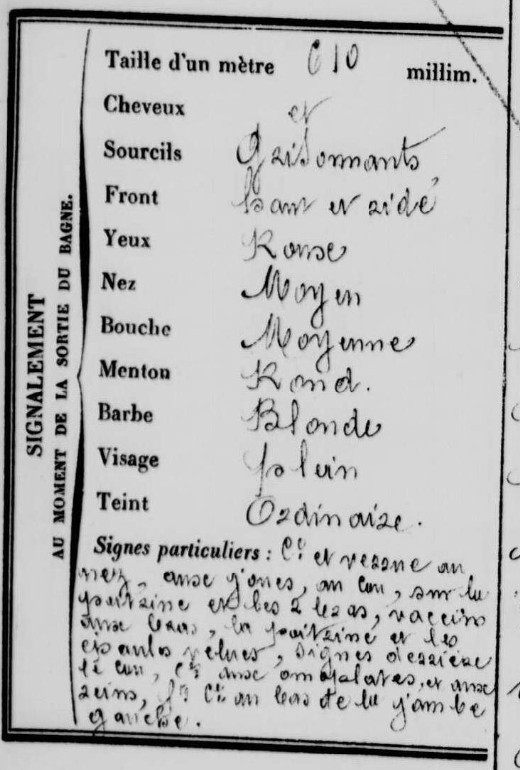I was certain the French archives would have good, solid information on historical prisoners, so went looking for them. And that’s how I found the official French archive site filae.com, which (modest paywall notwithstanding) was actually very impressive (To be precise, searching filae is a bit hit and miss, but the depth of the archives is excellent.)
So I can now say with certainty what happened to Jean Keff and Pierre Keff (oddly, I wasn’t able to find prison records for Marie Ratier, the widow Bon).
What Happened to Jean Keff?
As we already know, Jean Keff was given a life sentence in 1872 for the attempted rape of minor Henriette X, and his appeal was rejected. He then escaped from Le Bagne de Toulon on 14 Oct 1872, but was recaptured on 22 Oct 1872.
His prison records take up his story. (There is a note that he had a previous 13-month conviction in 1860.) For attempting to escape, he was sentenced to three years in ‘double chains’. He was then unchained on 25 Jan 1873 and transferred to Nouvelle-Caledonie on the transport ship Le Rhin. There, his attempts to escape continued:
- 20 Oct 1873: escaped Ile Nou, recaptured 22 Oct 1873
- 23 Dec 1875: escaped Ile Nou, recaptured 25 Dec 1875
- 1879: escaped Ile Nou, recaptured
- 4 May 1880: escaped Ile Nou, recaptured on the 6th
- Jul 1884: not sure what happened here
Sadly, the final entry in Jean Keff’s three pages of prison records isn’t hard to predict:
- Died at Ile Nou, 10 Feb 1894
What Happened To Pierre Keff?
From the reports we have already seen, we know that Pierre Keff too was given a life sentence in 1872 for his part in the conspiracy to rape Henriette X. His appeal against the sentence was upheld, but he was due to be rearrested and retried.
From his prison record, we can see that that the sentence given to him in his retrial was 15 years: he arrived at Le Bagne de Toulon on 09 Sep 1872. As with thousands of other bagnards, he was subsequently transported to Nouvelle-Caledonie on 18 Apr 1873. Despite escaping from Ile Nou (on 02 Dec 1873), he was recaptured on 14 Dec 1873.
However, when the authorities responded (on 06 May 1874) by extending his sentence by two years, that punishment seems to have put him off trying to escape again, because – unlike his brother Jean’s long list of escape attempts – the next event in Pierre Keff’s prison record is his release on 11 Aug 1889, 17 years after his trial.
A search of filae.com’s death records found the same Pierre Keff (still born in Chateau-Rouge to Pierre Keff and Catherine Andre, but now a widower of Catherine Derichelle) dying in Paris at 11.45am on 15 Jun 1911. His brother Jean is also mentioned here as having died in Ile Nou.
So I think there is, alas, no way that Pierre Keff could have been Henry Debosnys.
So… Where Next?
Given that I mistrust just about everything wife-killer Henry Debosnys claimed as his history; that his body had what looked like prison tattoos (the Philadelphia Times noted that Debosnys seemed like a French convict); and that the French journalist claiming to have known him thought his real surname was Keff and that he was born around 1833, it wasn’t entirely unreasonable to wonder whether Pierre Keff – born 1833, and sent to Le Bagne de Toulon for conspiracy to rape a minor – might have been both people.
Intriguingly, Stefano Guidoni notes that Debosnys’ Portugibberish notes included the word “noumea”, which is the capital of Nouvelle-Caledonie. So, much as I doubt both the veracity and the sincerity of all Debosnys’ writings, there remains a vague suspicion that there may be something real peeking through the cracks there.
But was this even the same M. Keff described by the Parisian journalist, “a good-sized fellow with long black hair, a smooth, fat always carefully shaved face“? Here’s his physical description when he left prison:
The blond beard sounds somewhat inconsistent, hein? But it is Pierre Keff’s profession – “polisseur” – that is arguably the most inconsistent with the journalist’s account.
I don’t know: right now, I doubt I’ve even found the right Keff, never mind the right Debosnys. And for Keffs, the French historical prison records list only the two brothers.
Perhaps the historical records of Charlemagne college will be able to throw a little more light on this, if (as claimed) Keff attended there in 1845 as a 12 year old. At this distance in time, this might be the only practical way to verify the journalist’s story. (Did he even have Keff’s surname correct? We don’t know.)
At the same time, I’m wondering whether it might be worth looking at escaped French convicts from the period 1870-1880. I mentioned a few before, but Docteur Raoulx might possibly have included a list in his 1929 book. Something to think about, anyway…
